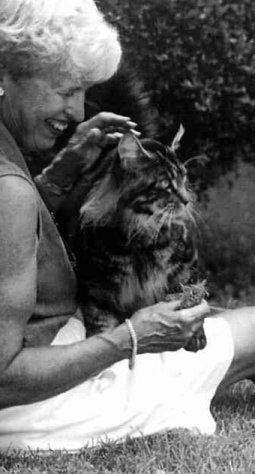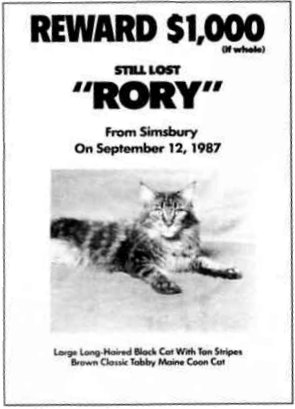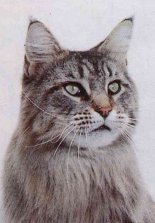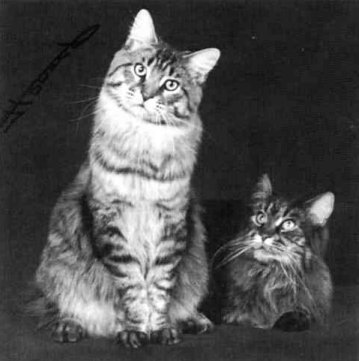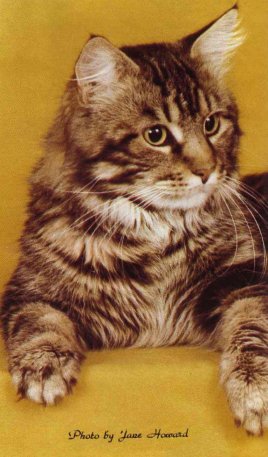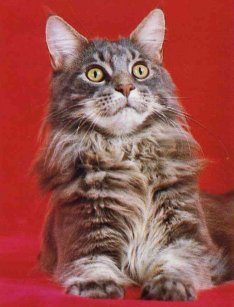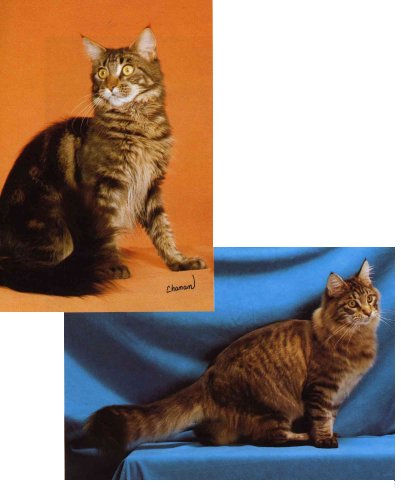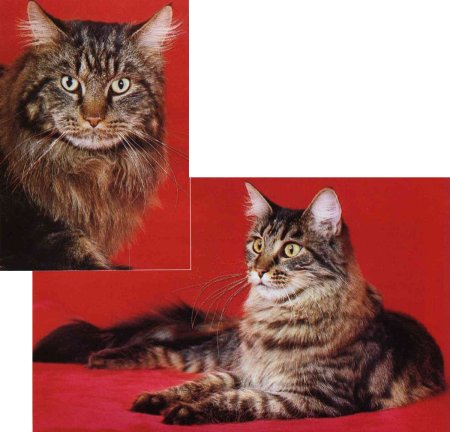| "This page was originally a part of the Maine Coon Heritage Site, a site that was first created in 1998 by Cynthia Bowen (Coontopia), Ulrika Olsson (Ylletrollets), Astrid Straver (Tricks and Tails) and Janet Marr (Furkats). It was then taken over by PawPeds, and it is now split up to fit better with the structure of PawPeds' website." |
 |
MtKittery Cattery - Barbara Washburn
A Visit to Malvern, near Philadelphia, brings us to the cattery of one of America's most prestigious breeders.
|
Barbara Washburn |
| Cattery Name: | MtKittery | |
| Established: | 1976 | |
| First Maine Coon: | BoChat's Kennebec | |
| First Breeding Queen: | Ktaadn's Chelsea of MtKittery |
Home to the MtKittery cats is a beautiful old house, set in eight acres of immaculate rolling lawns and shrubberies, just outside Malvern, a town near Philadelphia. Barbara Washburn (known to all as Bunty) is not at all what I might have expected of someone with such a long, famous and revered history in the Maine Coon world. Bunty is friendly, chatty, witty and fun - and very difficult to keep up with. Rarely have I met anyone so full of energy and enthusiasm. And maybe it is this very energy, interest and enthusiasm for all things which keeps the MtKittery name to the forefront of our breeding world, even after 20 years, when lesser mortals may have slowed down and voted for retirement and the easy life!
Bunty's first Maine Coon, BoChat's Kennebec, joined her household in 1976. She, in turn, led the way for the arrival in 1977 of MtKittery's first breeding cat, a girl called Ktaadn's Chelsea of MtKittery. I rather tentatively asked whether she set out to get very specific cats or, heaven forbid, whether the whole thing was something of an accident, quite expecting to be told firmly that the whole thing was, of course, carefully planned. The reply was refreshing: "Oh, by accident, of course, everyone knows that. After being checked out by George and Helen Andre (Illya) I bred Chelsea to Illya's Shem, and then to their Saco Buoy. At a Pittsburgh show, I met Connie Condit and fell in love with her cats. From her I acquired Heidi Ho Aurora, a very feral girl with a long muzzle, totally different from what I had seen around at the time. I bred her to MtKittery's Schoodic, my first CFA Grand and first TICA Supreme Grand, an older type cat, and from this breeding came MtKittery Macwahoc, who was subsequently bred to Rory (Aurora). I had no knowledge of the implications, good or bad, of inbreeding at the time and it was all down to the best luck in the world that the breeding set my line for me, producing some of my best boys, MtKittery Rumford, Pemaquid and Penobscot."
An unplanned trip!
|
When Rory went missing |
In fact, Aurora's breeding line very nearly ended before its time when Rory was sent out of state to someone else's stud to be bred and, unfortunately, escaped while away. Bunty had had posters printed, offering a large reward and had made a special trip to the area, searching high and low, all with no success. After Rory had been missing for seven weeks, Bunty made one final trip and was searching in a new area before returning home, when: "For no known reason, I drove straight on down the road was on, instead of turning off as I would normally have done to get back to where I was staying. Driving along, I spotted a cat walking along the sidewalk, very dishevelled but somehow reminding me of Rory. I leapt out of the car, whistled my special cat call, to which she responded, grabbed the cat and rushed her back, putting her into the car and then studying her closely. I was so excited and so worried - and she looked so unlike the Rory I knew - that I didn't dare to trust my own judgement. There was a man in a garden nearby - someone I had never seen before in my life - and I went over to him, showed him the 'Lost' poster and asked him if he really thought I had the right cat!! Happily, he looked at her and said yes, he did think it was one and the same cat and I went off home to Pennsylvania with my Rory, whom I had begun to believe I would never see again." Rory is alive and well and still living with Bunty in Pennsylvania at the grand age of fourteen.
|
SGC/SGCA GRC/GRP |
After a time, Bunty felt that, as she says, the writing was on the wall and she could not go on breeding more and more feral cats, so she modified her line with Beauport Colby of MtKittery; a 'crossover' cat, popular in both CFA and TICA (CFA GrCh, TICA SGC). The mating of Colby to Pemaquid produced TICA SGC/SGCA, CFA GRC/GRP MtKittery Machias, TICA's International 3rd Best Alter, 1994, Best Maine Coon Premier in the North Atlantic Region of CFA in 1995 and TICA's 20th Best Alter in 1996. The same breeding also produced SGC MtKittery Bridger of TwoChats, who did well in the mid-west, SGC/GrC MtKittery Lewiston, 5th Best in the TICA mid-Atlantic Region and Congress Winner at the Penn Jersey Show in 1995, Ch MtKittery Hadley, now doing well in Denmark and Ch MtKittery Loring, at present involved in rearing kittens to carry on the line. Bunty has one whole male in residence TICA DGC/CFA Ch Britches Kennebago of MtKittery, (an offspring of SGC/GrC MtKittery Carbonero of Emlu and SGC/Ch Mysticoon Clementine of Britches) who is a good example of the feral Maine Coon. Several other males are living elsewhere and co- owned - TICA SGC/CFA GrC MtKittery Lewiston, TICA SGCI CFA GrC, FIFe Int GC MtKittery Pemaquid and TICA QGCI FIFe Int GrCh MtKittery Bemis. However, Bemis has temporarily returned home to stand stud there.
Preferring brown tabbies
Although Bunty made the choice to temper the type of her cats somewhat, she still favours both styles of Maine Coon, for different reasons. She loves the boning of the New England cats and prefers the shaggier coat which, she says, works successfully in the crossover mating. Aurora took three years to come into full coat but looked magnificent when she did. Her preferred colour has always been brown tabby - as she puts it "If it wasn't brown in CFA, forget it!" In her concentration on breeding remarkable brown tabbies, one of her most famous achievements - and not necessarily the most deliberate or the most welcome - is Macwahoc. Remarkable in many ways, he will be remembered specifically by many for the fact that, as Bunty will tell anyone, he is brown classic on one side, brown mackerel on the other! At all events, she has recently branched into silvers, although she believes the browns are still generally preferred - in the NE Regional Show, brown tabbies took Best of Breed in every ring but one, which was won by MtKittery Silver Ridge.
|
MtKittery Surry of Macspurr |
She believes that, once one is used to one's own cats' breeding patterns, 16 weeks is the earliest time to safely predict the show/breeding potential of a kitten, although it is still easier at seven to eight months. As she puts it, "Some you win, some you lose!" As far as specific characteristics are concerned, she puts disposition ahead of visual characteristics, to begin with, and feels that many breeders have forgotten the importance of the temperament. As she says, "If you can't work with a cat, then you have nothing, regardless of looks." For visual success, she looks for heavy bone, a good chin, good coat and general balance. "A Maine Coon doesn't have to be pretty. It must fill your eye." Bunty has been asked to become a judge but prefers simply to continue showing her own cats - she enjoys showing and began with show horses, with her children competing in horse shows and mounted games competitions. Later, when the children went away to college, she started showing her cats. As she says, with a country as vast as the USA, the competition is not the only enjoyable part of showing the social aspect is also a high consideration, with friends being brought together across the country. The same is true of club membership. Bunty was, for four years, President of the MCBFA and this in itself brought introductions to many other breeders, at home and abroad.
Study well - be prepared for mistakes
|
SGC/GCH MtKittery Schoodic |
Her advice to new breeders is to do their homework well. She says "Go, to shows, study the cats, talk to friendly breeders. It is normal to make mistakes - my first breeding cat, Chelsea, was not the best cat ever but it was very generous of Liz (Eastman, Ktaadn) to sell her to me, a newcomer. George and Helen Andre (Illya), Mary Buckmaster (MaryB) and Liz were all of enormous help to me in the beginning. But it was a different time then. The most-used registries were CFA, ACFA and CFF - TICA was not yet formed - and things have to be different, now. But new breeders will still make their own mistakes." Following the thought of changes in method and attitude, Bunty says that she really dislikes the modern tendency to strip the Maine Coon coat, a method employed by same breeders to bring out the pattern in the coat. She firmly believes that this should be a disqualifying fault. This is America's own breed, a natural breed and the oldest show breed, even before the Persian - and a natural breed it should remain! She also believes that there is still a place in the breed for unpedigreed foundation cats - but these MUST be used in a controlled breeding programm, rather than being mixed in ad lib.
|
GC/GRC MtKittery Penobscot |
Asked whether she favours repeated outcrossing or judicious linebreeding, she says she believes both have their place. Schoodic was an outcross to Aurora and produced good kittens. After Schoodic's death, the obvious progression was to use his son, Macwahoc, which then created a very close linebreed in her pedigrees. The cats which she believes to have been essential to the strength and consistency of her lines were Aurora, Schoodic in his way and Colby for moderation - she made the right match for Pemaquid and also Penobscot, with whom she produced a litter of ten kittens, all of whom survived. What worries Bunty now is that the enjoyment in choosing these matches and appreciating the individual cats for themselves will be lost, since the breed is enjoying so much of a rise in popularity, and that this new popularity will encourage breeders to become money- and business-orientated, with the result that the cats will be the ones to loose.
Achieving a look
|
top: Heidi Ho Aurora of MtKittery |
The discussion then moved on to the variety of 'looks' or 'styles' of Maine Coons today. Bunty agrees that there is much visual variety in the breed, as witness her deliberate choice of Colby to moderate her existing cats from one acceptable look to another. The look, she says, will usually depend on the line concerned and pedigrees and previous litters should be carefully studied before any outcross is entered into, to avoid undesirable changes in characteristics. By judicious outcrossing, a fault can be corrected without changing the entire 'look' of the line. And cats with faults CAN be valuable breeding cats. But it is better to confine oneself to a cat with just one fault, with a high chance of being able to choose the right breeding to be able to correct it quickly, rather than risking perpetuating a whole bunch of small problems. But what if you make a major mistake and lose your way toward what you were originally aiming for? Should you go back and start over with new cats or keep trying with what you have, simply changing the way you go about breeding? Bunty says she has seen it happen both ways - and in the end, it usually comes down to time vs. money - those with plenty of time can work at what they have and progress slowly and steadily again. Those with plenty of money may prefer not to wait that long and to go off and buy new cats and begin all over again. Each method will have its advantages and disadvantages.
These days, Bunty works closely with several other catteries, notably Mainlysilver (Bonnie and Mike Pilar), with QGC/Ch MtKittery Dresden and SGC/GrC MtKittery Penobscot, and she is in partnership with Dortemarie Kapiers of Guldfakses in Denmark. Although, as stated earlier, her preference is still for brown tabbies, she believes it is too easy to box oneself in if one sticks too stringently to one colour or characteristic and avoids the other opportunities available to add to one's lines. She says that she knew no better when she began and that buyers were only really looking for brown tabbies but believes that modern thinking has given breeders and buyers alike more choice.
|
top: MtKittery Macwahoc |
Then, the $64,000 question - simply speaking, what is her philosophy and how has she achieved the successful line she has today? To the first part, she answers simply that, over-popularity notwithstanding, she welcomes the acceptance of the breed world-wide but believes that we must all be very vigilant against unscrupulous and financially-driven breeders ruining the breed with poor breeding practices. But the $64,000 answer to the second part regarding her success: "Hit and miss and dumb luck". As an example, when a litter produced by SGC/GrC MtKittery Penobscot and SGC Kiskata Quoddy of MtKittery was delivered by one of Bunty's co-owners, Bunty immediately picked out at the age of nine weeks MtKittery Casco as a potential show cat. He subsequently showed very successfuIly in both the USA and Europe, gaining the titles of TICA SGC, CFA GRC and European GrCh. If you ever hear that the success is because she's clever, or good at it, or has a good eye - well, you must be talking to someone else!
© "Maine Coon International", issue 7, 1996.
Reprinted with permission.

